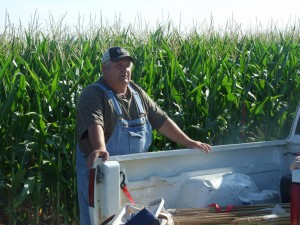Should Bad Predictions Be Punished?

Government corn predictions are based on the work of people like Phil Friedrichs, gathering data in a corn field in Hiawatha, Kansas. (Photo: Stephen Koranda)
What do Wall Street forecasters and Romanian witches have in common? They usually get away, scot-free, with making bad predictions. Our world is awash in poor prediction — but for some reason, we can’t stop, even though accuracy rates often barely beat a coin toss.
But then there’s the U.S. Department of Agriculture’s crop forecasting. Predictions covering a big crop like corn (U.S. farmers have planted the second largest crop since WWII this year) usually fall within five percent of the actual yield. So how do they do it? Every year, the U.S.D.A. sends thousands of enumerators into cornfields across the country where they inspect the plants, the conditions, and even “animal loss.”
This week on Marketplace, Stephen J. Dubner and Kai Ryssdal talk about the supply and demand of predictions. You’ll hear from Joseph Prusacki, the head of U.S.D.A’s Statistics Division, who’s gearing up for his first major crop report of 2011 (the street is already “sweating” it); Phil Friedrichs, who collects cornfield data for the USDA; and our trusted economist and Freakonomics co-author Steven Levitt.
We’ll also hear from journalist Vlad Mixich in Bucharest, who tells us why those Romanian witches might not be getting away with bad fortune telling for much longer.
Here’s where to find Marketplace on the radio near you.

Comments